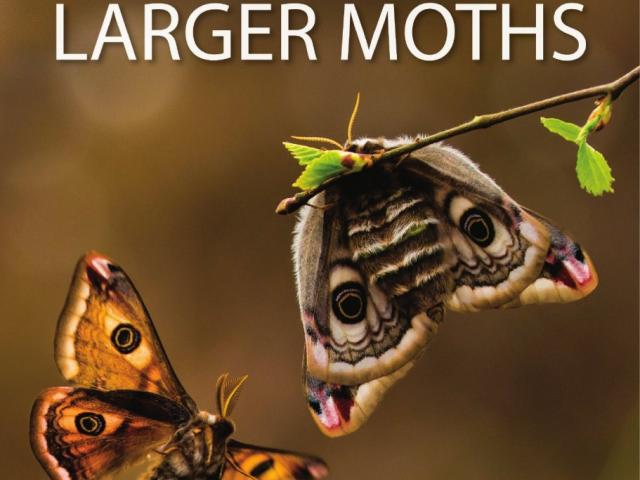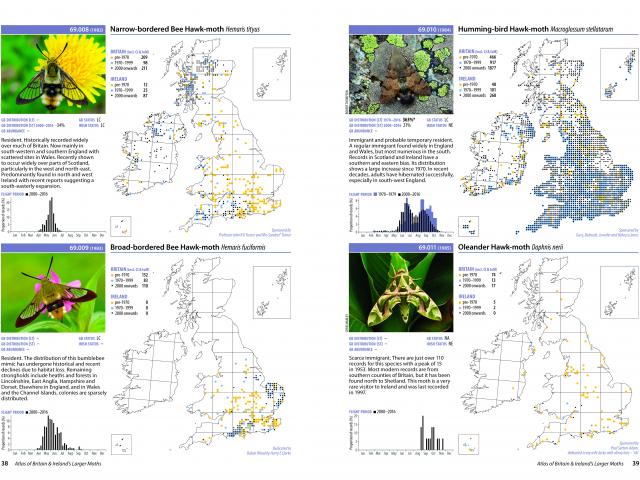For as long as I, my colleagues and co-authors can remember, our working lives have revolved around getting the Atlas of Britain and Ireland’s Larger Moths completed and sent to print.
This accomplishment has now been achieved and the book will be published on 25 November 2019. You can order your copy here www.naturebureau.co.uk/atlas-of-britain-irelands-larger-moths.
The atlas is beautifully illustrated with over 800 colour photographs and displays distribution maps showing current and historical records for 893 species. Distribution trends and abundance trends are presented along with the IUCN Red List status for Great Britain and for Ireland. Phenology charts have been produced for 866 species, the majority of these compare the flight period of the moth in the 1970s with 2000 to 2016. These provide some interesting insights into how some species are responding to climate change by changing their phenology, for example by flying earlier in the year, or by being able to have a second generation much further north than was possible in the 1970’s.
I embarked upon this ‘atlas phase’ of my life with a fair degree of naivety but have learnt a great deal and am all the better for it. Along the way there have been personal and professional opportunities and obstacles to tackle and embrace, but I am pleased to say we made it. The feeling of the book having gone to press is one of great relief and major achievement.

This landmark publication, the first-ever atlas of larger moths in Britain, Ireland, the Isle of Man and the Channel Islands was produced in partnership with MothsIreland. It comprises over 25 million moth records from Butterfly Conservation’s National Moth Recording Scheme (NMRS) and the MothsIreland dataset. The atlas includes records up to 31 December 2016, with the earliest record being that of Kentish Glory recorded in April 1741, therefore spanning an impressive 275 years of moth recording effort.
The moth auction
As you might expect then, this book is full of beautiful photographs of the 867 species featured. Interestingly it was difficult to source cracking photos of common and widespread species such as Heart and Dart. Is this because the appearance this species could be considered to be that of a moth-ers moth, a bit brown, not particularly photogenic or interesting to look at, unworthy of a photoshoot? The same cannot be said for Scarlet Tiger, which was also one of the last images to be sourced, a moth that would give all butterflies a run for their money in the beauty stakes and well deserving of the front cover of Vogue! Tracking down good images for rare immigrant species was understandably tough, take Minsmere Crimson Underwing for example, there is only one British record, so a European colleague provided an image. In total over 70 photographers freely provided and allowed us to use their images in the atlas, we are very grateful to all of them – thank you.
Funding also needed to be sought to help finance the production of the atlas. For the first time we tried an eBay style moth auction. Auction lots were advertised, and people could bid for their favourite species. In return they could have a personal dedication on the species page. A few species were highly sought after and we saw a bidding war, two species attracted 26 bids each. I was determined to bag the Satellite and my persistence paid off! Over 400 people and organisations joined in the moth auction and sponsored species, many thanks to all of you for helping us to raise the necessary funds for the atlas. We also secured funding from several trusts and corporate sponsors, again we thank them all for their support.
At the early design stages of the book, we had to consider its dimensions and weight with regard to postage costs, no-one wants to buy a book and then pay half of its cover price again in postage! With the huge number of species we needed to include in the atlas we didn’t want to have to go to two or more volumes either, the book had to be affordable and desirable. Thus, space on each page was a premium and the species account text needed to be concise, around 336 characters including spaces. The text is an aid to interpreting the maps, trends and phenology (flight) charts, not regurgitating information that is readily available in the various field guides. It was quite a challenge to keep the text short and snappy.
Ensuring accuracy was key

The data in the NMRS are not collected in a standardised way, traps are run for different durations, there are various trap and bulb types, not everyone records abundance and many records are ad-hoc as the scheme accepts data for any moth, any life-stage, anywhere at any time. Fortunately, due to advances is statistical techniques it is now possible to generate distribution trends using this type of data. As a result, distribution trends for Great Britain were generated from the NMRS dataset. We had to exclude the Irish data as it is currently too sparse to produce meaningful trends, however, as moth recording is growing in popularity in Ireland, as it is elsewhere, and the number of records submitted annually is increasing massively, distribution trends for Ireland will be calculable in future.
We also wanted to include abundance trends in the atlas. In order to do this count data needed to be collected in a standardised scientifically robust way. The source of these data was the Rothamsed Insect Survey (RIS) light-trap network, the light-trap network has a standardised trapping protocol and traps are run on a nightly basis throughout the year and have done so since the late 1960s. Statisticians at the Centre for Ecology and Hydrology generated these abundance trends for us to use in the publication. Again, these trends are GB only as there are currently too few RIS monitoring sites in Ireland to generate meaningful trends.
Ensuring the accuracy of the distribution data was a vital part of the atlas production process. We produced distribution maps for all of the species featured in the atlas and circulated these to Butterfly Conservation staff and a panel of regional experts for scrutiny and potential ‘dodgy-dot’ spotting. Once these possibly erroneous records were highlighted, they were referred back to the County Moth Recorder network for further investigation which resulted in acceptance or omission of said records. Thanks to the checkers and the County Moth recorders for responding every time.
This book is an absolute treasure trove of information detailing the changing fortunes of our resident and immigrant moths. I hope it will be considered as an essential addition to every moth recorders’ personal library.
Acknowledgements:
We would like to thank the County Moth Recorder network and moth recording community, the photographers, species sponsors, trust funds, corporate sponsors, Rothamsted Insect Survey, the Centre for Ecology and Hydrology, NatureBureau/Pisces Publications and everyone else who has had a role to play in the production of the Atlas of Britain and Ireland’s Larger Moths.


